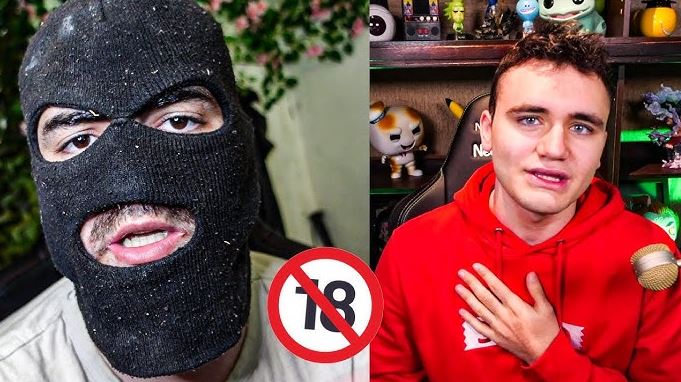Neo The One Qui Se Pignouf Video Exploring the Ethical Boundaries of Sensitive Content in Digital Media
In the realm of digital media, the dissemination of sensitive content raises critical questions about privacy, consent, and the ethical boundaries of sharing. As digital platforms continue to expand, the lines between acceptable and inappropriate content blur, creating complex scenarios for content creators, consumers, and regulatory bodies.
The discussion of sensitive content in media is crucial not only for understanding the impact of such content on audiences but also for shaping the policies and practices that govern digital spaces. It ensures that stakeholders are aware of the consequences of exposure to sensitive material and helps in crafting guidelines that protect individuals while supporting freedom of expression.
“Neo The One Qui Se Pignouf” emerges as a significant example in this ongoing dialogue. This pseudonym or title, associated with a particular video or series of videos, highlights the challenges and complexities of handling sensitive content. The case provides a concrete scenario to explore the implications of sharing potentially controversial material and the reactions it elicits from different quarters.
Content
Background Information
“Neo The One Qui Se Pignouf” refers to a content creator or a specific content piece known for its controversial or sensitive nature. While the exact origins or the identity behind this name may be wrapped in ambiguity, it typically signifies a figure or content that pushes the boundaries of traditional media content. This can involve themes that are provocative, deeply personal, or contentious, drawing public and critical attention.

The platform or medium that hosts a video like “Neo The One Qui Se Pignouf” plays a crucial role in its dissemination and reception. Platforms such as YouTube, Vimeo, or more niche digital spaces can influence the extent of the video’s reach and the audience it attracts. These platforms come with their set of regulations and community guidelines that determine how sensitive content is managed. For instance, YouTube has strict policies regarding content that could be considered sensitive or offensive, including age restrictions and warnings to viewers. Understanding these mediums provides insight into how such content navigates the digital landscape, the potential for viral spread, and the regulatory challenges it poses.
This background sets the stage for a deeper exploration of the impact of “Neo The One Qui Se Pignouf” on viewers, the ethical considerations for creators and platforms, and the broader implications for digital content regulation.
Content Analysis Video
“Neo The One Qui Se Pignouf” video features content that delves into deeply personal or controversial themes. The video may explore topics such as mental health struggles, social injustices, or other profound societal issues that evoke strong emotional responses. The visual and auditory elements are crafted to enhance the emotional depth and complexity of the subject matter, often using stark imagery, intense narratives, and potentially provocative symbols to challenge the viewer’s perceptions and provoke dialogue.
Neo The one qui se pignouf video HD 1080p Full Alluring and Hot Clips
Neo-The-one-qui-se-pignouf-video.mp4
The sensitivity of the content in “Neo The One Qui Se Pignouf” arises from its exploration of topics that are typically taboo or uncomfortable for general audiences. This could include graphic depictions of violence, explicit discussions of sexual content, or the portrayal of mental illness and suicide. These elements are considered sensitive as they can trigger emotional distress or discomfort in viewers, particularly those who may have personal experiences related to the themes discussed.
Reception to “Neo The One Qui Se Pignouf” varies widely. Some segments of the audience praise the video for its raw portrayal of important issues, appreciating the courage to bring such topics into the open. However, others may find it too provocative or distressing, leading to criticism for its handling of sensitive themes. Critics might debate the artistic merits of the video, discussing whether it succeeds in its intent to educate and inform or if it merely sensationalizes serious issues for shock value.
Impact of Sensitive Content
The psychological impact of watching “Neo The One Qui Se Pignouf” can be significant. Viewers might experience a range of emotions, from empathy and solidarity to distress and anxiety, depending on their personal backgrounds and sensitivities. For individuals with direct experiences related to the content, the video might trigger traumatic memories or feelings, necessitating a thoughtful approach to viewer warnings and accessibility. Mental health advocates often stress the importance of trigger warnings and supportive resources when disseminating such content.

The social implications of “Neo The One Qui Se Pignouf” are equally profound. By bringing sensitive issues to the forefront, the video has the potential to initiate public discussions on topics that are often ignored or stigmatized. This can lead to greater awareness and potentially inspire changes in societal attitudes or policies. However, the video could also polarize opinions, leading to debates over censorship, the role of media in social issues, and the balance between freedom of expression and protecting community sensibilities.
Community response to the video might include organized discussions, support group meetings, or public protests, depending on the content’s nature and impact. Regulatory bodies might step in if the video is found to violate content guidelines, leading to its restriction, removal, or the need for age gating. The response from regulators highlights the ongoing challenges in governing digital content that balances creative freedom with social responsibility.
Overall, “Neo The One Qui Se Pignouf” serves as a case study in the complexities of managing sensitive content in the digital age, raising questions about artistic expression, viewer protection, and the societal role of media in addressing and reflecting on challenging topics.
Ethical Considerations
The ethics of sharing and displaying sensitive content like that in “Neo The One Qui Se Pignouf” video necessitates a nuanced examination. One central ethical question is whether the potential benefit of raising awareness about difficult topics outweighs the risk of causing distress or harm to viewers. Content creators and distributors must consider the impact their work has on various audience segments, especially vulnerable individuals. There is an ethical responsibility to implement measures such as trigger warnings or appropriate content ratings to help viewers make informed choices about their exposure to potentially upsetting material.
Balancing the right to freedom of expression with the responsibility to protect individuals from harm is a key ethical challenge in the digital age. While creators should be free to explore and discuss all aspects of human experience, they also bear a responsibility not to cause undue harm. This balance can be particularly difficult to achieve with sensitive content that may have both profound educational value and the potential for significant emotional impact. The goal should be to foster an environment where creative freedom can thrive without compromising the well-being and dignity of individuals.
Comparative Analysis
“Neo The One Qui Se Pignouf” can be compared to other provocative works like the “13 Reasons Why” series, which also faced scrutiny and discussion over its handling of sensitive themes such as suicide and mental health. Both cases raise important questions about the line between illuminating societal issues and potentially glamorizing or mishandling them. Comparisons can be drawn regarding the approach to content warnings, the narrative techniques used to engage with sensitive subjects, and the subsequent public and critical reaction.

Different platforms have developed varied approaches to managing sensitive content. For example, YouTube often places age restrictions or content warnings before videos that discuss or depict sensitive topics, whereas streaming platforms like Netflix provide detailed viewer advisories and direct access to mental health resources. Social media platforms like Facebook and Instagram have implemented sophisticated algorithms and user-reporting tools to identify and limit the spread of potentially harmful content. Over time, a trend towards more stringent regulations can be observed, reflecting a growing recognition of the platforms’ roles in safeguarding mental and emotional health.
These platforms are continually refining their policies in response to user feedback and regulatory pressures. There is a visible shift towards more proactive measures in content management, suggesting a broader industry movement towards ethical responsibility. The handling of sensitive content is increasingly seen not just as a legal obligation but as a moral one, influencing how platforms shape their content policies to accommodate both the creators’ rights to express and the audience’s right not to be unduly harmed.
In conclusion, the discussion surrounding “Neo The One Qui Se Pignouf” and its comparative analysis with other similar content highlights the ongoing evolution in the ethics of media production and distribution. It underscores the need for a balanced approach that respects creative freedoms while ensuring rigorous protections for viewers, setting a framework for future content creators and platforms to follow in the responsible handling of sensitive subjects.
Regulatory and Legal Perspectives
The legal framework surrounding sensitive content in media is complex and varies significantly across jurisdictions. In the United States, for instance, the First Amendment provides broad protections for freedom of speech, which includes the right to publish sensitive material. However, there are restrictions related to obscenity, child pornography, and the right to privacy that limit this freedom. In Europe, the General Data Protection Regulation (GDPR) provides stringent guidelines on the processing and dissemination of personal data, which can include sensitive content shared in media.
Different countries have unique regulations that impact how sensitive content is handled. For example, Germany has strict laws regarding hate speech and Holocaust denial, which must be adhered to by all media operating within its borders. Similarly, platforms like YouTube and Facebook have developed their community guidelines that prohibit explicit content, hate speech, and harassment, applying these rules globally despite regional legal differences. These platforms use a combination of algorithmic and human moderation to enforce these guidelines, often resulting in a contentious debate about the balance between censorship and freedom of expression.
Public Reaction and Feedback
Viewer feedback on social media and online forums can provide a snapshot of public sentiment towards sensitive content. For videos like “Neo The One Qui Se Pignouf,” reactions can range from supportive to critical. Supporters may praise the courage to tackle tough subjects, whereas detractors might criticize the approach as insensitive or sensationalist. Analyzing these reactions can give content creators valuable insights into audience sensitivities and preferences, influencing how they approach future projects.
The public reaction to sensitive content can have a significant impact on a creator’s future work and public image. A strongly negative reaction might lead a creator to adopt a more cautious approach in future projects, while positive feedback can encourage more bold explorations of similar themes. Ultimately, the creator’s ability to navigate public sentiment and legal constraints will play a crucial role in shaping their career trajectory and legacy.
This discussion has explored the intricate landscape of creating, sharing, and regulating sensitive content in digital media. From the ethical considerations and audience reactions to the regulatory frameworks and legal challenges, it is clear that navigating this space requires a careful and informed approach.
The future of content creation with sensitive material looks to be increasingly governed by a combination of stricter platform guidelines and evolving public expectations. As digital media continues to grow in influence, the responsibility of content creators to handle sensitive topics thoughtfully and respectfully will become ever more critical.
The ethical responsibility in digital media extends beyond legal compliance to a moral obligation to consider the potential impact of content on audiences. As technology advances and the global exchange of information expands, the need for ethical guidelines that transcend borders and cultures becomes paramount. Creators, platforms, and regulators must work together to foster an environment where sensitive content is handled with the care it demands, balancing the right to free expression with the need to protect individuals from harm. This ongoing dialogue will shape the ethical landscape of digital media for years to come.
Breaking News -Anita Brown Video Leak Navigating the Challenges of Privacy and Ethics in Digital Media
Vanessa n Evil Video A Deep Dive into Digital Privacy and Ethical Boundaries
Dancer Mikaila Murphy Video Sparks Discussion on Privacy and Social Media Boundaries
Neymar Video Leak Privacy Invasion and Its Impact on Public Figures
Tiktoker Ama Video Leak Sparks Debate on Privacy and Ethics in Social Media
Marissa Dubois Video Leak A Case Study on Privacy and Media Responsibility in the Digital Age
MC Mirella Video Scandal A Deep Dive into Privacy and Media Ethics